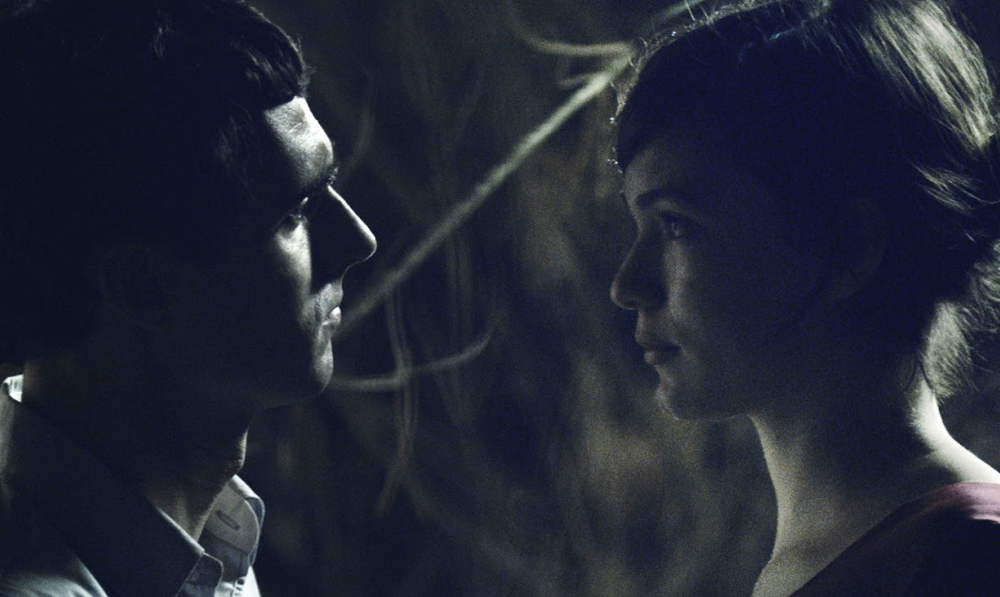On Nick Matthews’ first feature “One-Eyed Girl”, there was one hard and fast rule – no one was allowed to say the “C” word.
“Sometimes I’d hear extras saying on their phone at lunch, “I’m on this cult movie,” recalls the Australian helmer of his psychological thriller. “I’d have to gently remind them, ‘Sorry, do you mind? I really don’t want to hear that word right now.’… I was really frightened that the cast would hear that word, and then they would suddenly start behaving spookily.”
Perhaps that’s what differentiates “One-Eyed Girl” from other films about lost souls looking for a place to congregate, yet “One-Eyed Girl” is still plenty spooky for all the right reasons. Opening with an overhead shot of the big city, a bird’s eye view that insists that there is little sympathy for those living in the metropolis below, the film concerns Travis (Mark Leonard Winter), a young psychiatrist whose job entails working with a number of at-risk patients who’s suffering through his own mental breakdown after one of them takes her own life on his watch. While he’s hardly seeking out help, Travis is intrigued by a woman (Tilley Cobham-Hervey) handing out pamphlets for a support group on his bus ride home, only to discover when he attends a meeting that the group isn’t what he thought at first. Then again, nothing is as it seems in “One-Eyed Girl,” which sees Travis lured away from the trappings of his urban life to fend for himself in the jungle.
“It was an opportunity to completely immerse people in two worlds that are completely anathema,” says Matthews, who with co-writer Craig Behenna fashions a potboiler that may may find tension in Travis’ internal struggle to hold on to his personal identity while reassessing what he values most in life, but beyond entertaining, actively involves the audience in similar soul-searching as benefits of both lifestyles emerge in the clash of cultures. As Matthews explained shortly before “One-Eyed Girl” makes its premiere at the Austin Film Festival, part of the inspiration came from his own alternative upbringing, a different way of thinking that ripples through every aspect of the film to make it something unique and intriguing.
It came about as a result of a couple of factors. One was we were accepted into a program down in Australia that was supporting low-budget filmmakers, so it’s in the vein of the Microwave programs from the UK where you’re given enough rope to hang yourself. We were accepted into that program as a team, David [Ngo, the film’s producer and editor], Craig [Behenna], and I, and with a romantic comedy, believe it or not. But we looked at that and we didn’t think it was quite right for the setup of that program, so I had a very, very rough concept in my head about a thriller about a girl who basically wants to leave an isolated religious community. That was just a seed of an idea and a couple of scenes that I’d sketched out, but we started talking about that and eventually, we began putting the emphasis of the story more on Travis.
Is it true you had some experience with an alternative community, perhaps not like the one in the film, but somewhat off the beaten path?
I have a mother who’s got a fairly expansive notion of raising kids, and thankfully, she enrolled me in a couple of different alternative schools. One of them was actually a school where we learned transcendental meditation when I was 10. Then unfortunately, that school closed down and there was another one that we found in the Adelaide Hills that was run by a child psychologist. It was a school that just had its own set of principles and its own unique rules like you weren’t allowed to be sarcastic, and you didn’t have to go to lessons if you didn’t want to. It was a great experience, but it was also a little bit insightful into the world of really tight-knit social communities and all its pros and cons.
I think there’s a kind of Stockholm Syndrome that happens in those kinds of communities, and as an adolescent, it’s that first time in your life when you start to really look at how you’re living and start to compare it with what you think normal might look like. That informed, at least in the very first instance, the seeds for this story, that idea perhaps of trying to start a conversation about what’s the right way to live.
Since you actually come from a cinematography background, was it interesting to work with a cinematographer on this film?
There was a great divide in the writing process where I was determined to leave behind that career. It was very deliberate decision on the part of both myself and David, the producer, to go from what had been the crafts that we had grown up with – David as an editor, and myself as a cinematographer – so we had this long, quite protracted writing process, and by the time I came to direct “One-Eyed Girl,” I felt probably more like a writer than I did really a cinematographer, but by the time you get on the set, you then find yourself saying, “Hey, let’s try the 15-mm lens, and let’s move it from here to here.” You realize, okay, there is there is a history and a relationship with visual storytelling there which, God willing, is useful as a director and will continue to be so.

One of the things that David and I were really interested in doing was finding people who weren’t recognizable in the cast, particularly for the Grace character. We didn’t want someone who when the film would open, and you’d see this girl and say, “Oh, yeah, she’s great. I saw her in ‘Transformers 3.’” I was lucky enough to have lots of people really interested in the script, which was great. It was a good way of energizing the project really early on to have casting agents say, “Oh, you know, I’ve got this girl who’s the next big thing, and she really loves it, and I’ve got this guy …” But we also set about engaging with everybody through social media and saying, “Hey, look, just send us a tape, and we’ll make a short list, and you might get a role in a movie.”
As it turns out, we had around 500 people send in tapes, some from overseas. It was a fascinating project in itself and a bit ironic that in the end I ended up with Tilly, who I ran into on the street, but there were certainly a group of people who were short-listed who I auditioned, and some of whom were really interesting. There was no choice once I really engaged with Tilly, and likewise with Mark Winter, I found the Travis role particularly very, very difficult to cast because he’s a brand of leading man that is very rare, particularly in Australia where male leads tend to be sold with their machismo. They have this Australian leading man thing, a rustic knockabout guy that can sort of build a fence and ride a horse and all of that whereas I was looking for someone who was urban and urbane as well, with a sensitivity that’s quite rare in men in general. I was very lucky that an actor friend of mine helped, telling me “There’s this weird cat called Mark Winter,” and I said, “I’ve never heard of him.” Then I started to watch some of his work, and I must admit, within about 10 seconds, I think I said, “That’s it. It’s done.”
Not to spoil the film, but what resonance did the film’s title, a play on the old proverb, “In the land of the blind, the one-eyed man is king,” have on writing the film?
It carries a lot of weight for a variety of reasons, probably namely in the sense that the film deals with people who deal in dogma of some form. In the beginning of the film, you’re talking about a man who has to sit over there on the other side of a desk from another human being, and assess them, [being] in a sense, the proverbial one-eyed man. Then, as the film progresses, the role of the protagonist perhaps starts skewing a little bit towards Grace more, becoming a shared protagonism. A lot of the tension of the story, I hope, is driven by the fact that she is a conflicted character in a way that she is not 100% sure that the dogma she is being living by is in fact truthful.
Because of where this film goes in its second half with big environments and plenty of characters, it boggles my mind that this is actually a micro-budget project. Was it difficult to pull off?
It’s inevitable that as a filmmaker, there is never an infinite amount of resources, and as a camera assistant, I worked on things that were $150 million dollars, and everyone was always barking at each other and saying, “You can’t have that.”
For us, the spirit of independent filmmaking is something that just has to overtake your mind, body, and spirit, and there are scenes in the film — in the underground railway stations — that are just me carrying a camera and chasing the cast around and getting booted off a train platform, then having to get on a train and bust it to another one. It’s probably that material where not having permits and permissions and things like that creates its own certain set of challenges. But in general, it’s not really something that affected me. We had a really passionate team of people, and with digital technology, there’s been a lot of leveling [of the playing field] that’s been happening in the last few years. In some ways, it validates you being more responsive and organic, and to perhaps do things that you couldn’t do if you had a bigger budget, so it’s quite an enabler because if we had a bigger budget, there’d be more at stake.

Yeah. The landscape in the film is not the quintessential Australian film landscape. There’s a lot of space in Australia, and there’s a great desire to sell that isolation to the rest of the world, so we often see deserts in our cinema. In “One-Eyed Girl,” the forest was in my head right from the beginning because I didn’t want to push the Australia factor and the idea of the poisonous desert with spiders and snakes and things that want to kill you. I wanted to create a landscape that was more psychologically dangerous. I needed a place where people could hide and do secret things, whether that was part of a romantic agenda or perhaps something more sinister.
So the forest was always in my head, and it was an interesting challenge to find somewhere that had that landscape, and given the film scheduling, we needed somewhere that had a farm property as well and wouldn’t mind us filming this weird, very dark movie on their property. Thankfully, we found a real life organic farm that the fellow who ran the farm actually had been tied up with a cult before, and he got very interested. At first, when I pulled up to the gate with the production designer, he said, “What the hell are you doing here?” But I managed to talk him down and said, “Look, you know, we’re making this movie,” and, still growling at us, he said, “What’s it about?” I said, “Oh, it’s about cults.” His whole tone just changed. He opened the gate and let us in. It took us about six months to kind of get him to really get on board, but once he did, he gave us everything.
Is it fun to create a cult with all its rules and rituals?
Yeah, absolutely. It’s really interesting because I have a great desire as a filmmaker to create an authentic atmosphere, both from the point of view of an audience, but also for the cast and crew because one of my missions was to make a place where everybody felt like they had landed in the special place themselves. It doesn’t always work. Of course, there’s the machinations of the process. You have equipment and cameras [that break the illusion] but I had this fantasy that we could just build it and just film, and there were things that we did to try to support that atmosphere.

If you thought you’d be making your feature debut with a romantic comedy, was it easy to do a 180° turn to making this?
Yeah, a 180° indeed. Everybody probably has different stories inside their own head, and I still have that same romantic comedy that I was interested in a long time ago. It’s something that we might make one day. But the spirit that I carry will carry into everything, I hope, and what I want to refine as I do more movies is creating that authenticity on the set and a great space for actors to do their best work. I’m really excited about doing that in all manner of genre.
“One-Eyed Girl” does not yet have U.S. distribution. It premieres at the Austin Film Festival on October 24th at 9:30 pm at the State Theater and will play again on October 28th at 9:30 pm at the Galaxy Highland 10.





